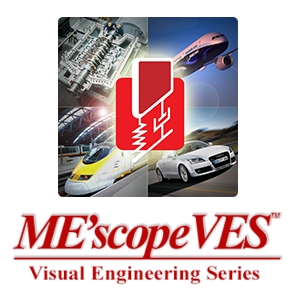
VT-560 Visual SDM Pro™
The Visual SDM Pro™ package combines all of the features of the Visual Modal Pro™ package with the features of the VES-5000 Structural Dynamics Modification option.
Once you have identified and quantified a resonance problem in a machine or structure, the next question is, “How can the structure be modified to fix the problem?”
Visual SDM Pro™ helps you quickly evaluate alternative solutions to resonance problems by adding additional tools to the modal analysis features of a Visual Modal Pro™ package. The Structural Dynamics Modification (SDM) method allows you to examine the effects of a variety of potential structural modifications on the resonances of a structure without actually having to make physical modifications.
The resonances (modes of vibration) of a machine or structure depend on its physical properties (geometry, density, elasticity, boundary conditions, etc.). Changing the physical properties of a structure by adding modifications such as stiffeners, brackets, tuned absorbers or other modifications, will directly affect its modes. The SDM method uses industry standard finite elements such as springs, masses, dampers, bars, plates, and solids to model the modifications. These modifications, together with the modes of the original (unmodified) structure, are used to calculate the new modes of the modified structure.
In the example shown below, a stiffener was added across the bottom of an aluminum panel. Adding the stiffener replaced the first mode of the structure (a bending mode at 73Hz) with a torsional mode at 94Hz. The torsional mode was the second mode of the original structure but was not affected by the rib stiffener. Without the added stiffener, machinery in the vicinity operating at 4000-4500 RPM would excite the first bending mode of this panel causing it to resonate. Adding the stiffener not only eliminated the mode at 73Hz, but also eliminated another mode at 143Hz, thus removing a potential resonance problem at 2X RPM as well.
VT-560 Visual SDM Pro™
Structural Dynamics Modification Features:
- Interactive graphical addition of structural modification elements to a structure model
- All visible FEA elements on a structure model are used by SDM. All hidden elements are ignored
- Modifications can be modeled using the following FEA elements; Point masses, linear springs and linear dampers, rod and beam elements, triangular and quadrilateral plate elements, tetrahedrons, prisms, and brick solid elements
- All FEA element properties are displayed and edited in property spreadsheets
- Modal Sensitivity Analysis. Define a solution space of FEA properties, and calculate new modes that minimize differences with target modal properties
- Sub-structuring. Two or more substructures can be connected together with FEA elements, and the modes of the combined substructures calculated
- Tuned absorbers. Multiple mass-spring-damper vibration absorbers can be attached to a structure model, and the new modes of the structure calculated
Multi-Reference Modal Analysis Features:
- Mode counting to identify closely coupled modes & repeated roots using either the Multi-Reference Complex Mode Indicator Function (CMIF), or the Multi-Reference Multivariate Mode Indicator Function (MMIF)
- Curve fitting using the Multiple Reference Orthogonal Polynomial method
- Multi-Reference Quick Fit. Automatically executes three curve fitting steps (count modes, estimate frequency & damping for each mode, estimate residues for each mode) with minimal user interaction
- Multi-Reference curve fitting using a Stability diagram and either the Z-Polynomial curve fitting method, the Complex Exponential curve fitting method, or the Alias-Free Polynomial (AF Poly) curve fitting method
- Stability A graphical display of frequency & damping estimates (poles) in differently colored stable pole groups. All poles are calculated using curve fitting model sizes ranging from 1 to a user-defined maximum
- Stable Poles A graphical display of poles (frequency & damping estimates) in differently colored stable pole groups
- Stable Pole Group. A group of solutions on a Stability or Poles diagram that satisfy a user-defined minimum number of poles that lie within user-defined frequency & damping tolerances
- Shape Complexity Plot. A graphical display of the complex shape components of one or more mode shapes
- Shape Component Magnitude Ranking. A graphical display of the ordered magnitudes of the shape components of each mode shape
- Shape Expansion. A set of shapes with many DOFs is curve fit to a set of shapes with few DOFs, to create new shapes with many DOFs in them
- Poles A graph of the modal frequency & damping estimates (poles) of a set of mode shapes.
MIMO Modeling & Simulation Features:
- MIMO Forced Response: Calculates multiple response time or frequency waveforms (outputs) caused by multiple excitation forces (inputs), using either FRFs or mode shapes to model the system dynamics
- MIMO Sinusoidal Forced Response. Calculates and displays response (output) shapes caused by multiple sinusoidal excitation (input) forces, using either FRFs or mode shapes to model the system dynamics
- MIMO Force Path Analysis. Calculates multiple excitation force time or frequency waveforms from multiple response (outputs), using either FRFs or mode shapes to model the system dynamics
- MIMO FRFs (Transfer functions). These frequency functions can be calculated from multiple excitation (input) and response (output) time waveforms, using Rectangular or Hanning time domain windows, triggering, linear or peak hold spectrum averaging, and overlap processing
- Multiple and Partial Coherences. These frequency functions can also be calculated together with MIMO FRFs. Multiple Coherence measures the overall contribution of all measured excitation forces (inputs) to each measured response (output), for each frequency. Partial Coherence measures the contribution of each measured excitation force (input) to each measured response (output), for each frequency.
- MIMO FRFs (Transfer functions) can be calculated from multi-channel Auto & Cross frequency spectra
Product Documentation